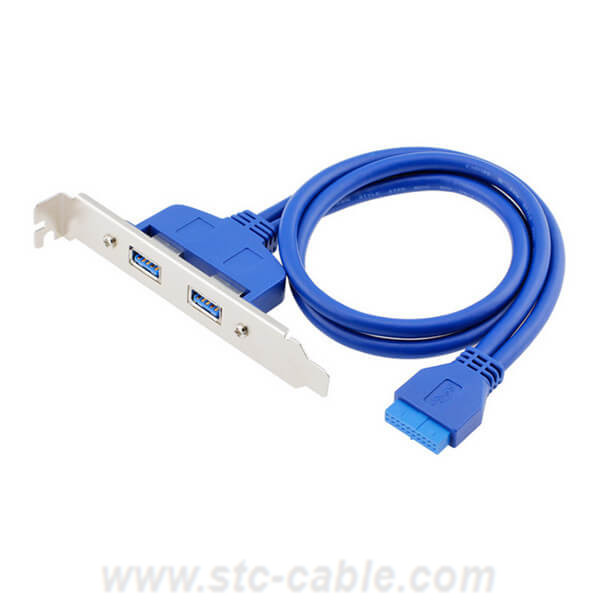Why do USB 3.0 need a power cable?
USB 3.0 (also known as SuperSpeed USB) does not inherently require a separate power cable. However, there are scenarios where additional power may be needed:
1. Power-Hungry Devices:
Some USB 3.0 devices, such as external hard drives or high-speed flash drives, draw more power than the standard USB port can provide.
In such cases, an external power source (usually an AC adapter or an additional USB cable for power) is required to ensure stable operation.
2. USB 3.0 Hubs:
USB 3.0 hubs allow you to connect multiple USB devices to a single port.
If you connect power-hungry devices to a USB 3.0 hub, the hub itself may need an external power supply to distribute sufficient power to all connected devices.
3. Long Cable Runs:
Longer USB cables (especially those beyond 3 meters) can experience voltage drop due to resistance.
To maintain proper power delivery, active USB 3.0 extension cables or hubs with external power can be used.
4. Charging Devices:
USB 3.0 ports can also be used for charging smartphones, tablets, and other gadgets.
While data transfer doesn’t require extra power, charging might, especially for fast-charging devices.
The USB 3.0 is backward compatible with USB 2.0, so you can still use USB 2.0 devices without any additional power requirements. If you encounter issues with USB 3.0 devices, consider checking the power requirements and using appropriate solutions.
What is the maximum power output of a USB 3.0 port?
A standard USB 3.0 port can deliver up to 900mA (0.9A), which translates into 4.5 watts at the standard 5 volts. If you’re fortunate enough to have a port equipped with the BC 1.2 charging feature, you can enjoy a robust 1.5A of power.
This represents a substantial increase from USB 2.0, which offered only 500mA of current and a maximum power output of 2.5W. So, USB 3.0 provides more juice for your devices!
Can I charge my laptop using a USB 3.0 port?
Charging a laptop directly from a USB 3.0 port is generally not recommended. Here’s why:
1. Power Limitations:
USB 3.0 ports provide up to 900mA (0.9A) at 5 volts, which is insufficient for most laptops.
Laptops typically require much higher power (usually 45 watts or more) to charge efficiently.
2. Voltage Mismatch:
USB ports deliver 5 volts, while laptop chargers provide higher voltages (e.g., 19V or 20V).
Connecting a laptop directly to a USB 3.0 port could damage the laptop or the port due to voltage mismatch.
3. USB-C and Power Delivery:
USB-C ports with Power Delivery (PD) support can charge laptops.
These USB-C ports negotiate power requirements and can deliver higher wattages (up to 100W) safely.
4. Use the Right Charger:
Always use the manufacturer-provided laptop charger for safe and efficient charging.
If you need to charge via USB, consider a USB-C PD charger or a dedicated laptop docking station.
Remember to prioritize safety and use the appropriate charging method for your laptop!
Can I charge my phone using a laptop's USB 3.0 port?
Certainly! When it comes to charging your phone via a laptop’s USB 3.0 port, here’s what you need to know:
1. Charging Speed:
USB 3.0 ports can supply up to 900mA (0.9A) at 5 volts1.
While you can charge your phone using a USB 3.0 port, it won’t necessarily charge faster than using a USB 2.0 port.
2. Device Compatibility:
Most smartphones will charge at the standard rate (around 500mA) when connected to a USB port.
Some devices with modified kernels might ignore the 500mA limit if they detect a USB 3.0 input source.
3. USB Cable Matters:
To take advantage of higher power, use a USB 3.0 cable along with the USB 3.0 port.
A USB 1.0/2.0 cable won’t deliver the same power.
4. Best Charging Option:
For faster charging, your phone’s wall charger is still the best choice.
Remember, while USB 3.0 can help, it’s not a guaranteed speed boost for phone charging.
Can I transfer data while charging my phone via a laptop's USB port?
Certainly! When you charge your phone via a laptop’s USB port, you can indeed transfer data simultaneously. Here’s how it works:
1. Charging and Data Transfer:
USB ports support both charging and data transfer.
When you connect your phone to a USB port, it can charge while allowing data exchange.
2. USB Modes:
Phones usually default to “File Transfer” mode (also known as MTP) when connected via USB.
In this mode, you can transfer files between your phone and the laptop.
3. Charging Speed vs. Data Transfer:
Keep in mind that data transfer may slow down charging slightly.
If you need faster charging, consider using a dedicated wall charger.
Remember, it’s a convenient way to multitask—charge your phone and transfer files at the same time!
Send your message to us:
Post time: Jun-15-2024
